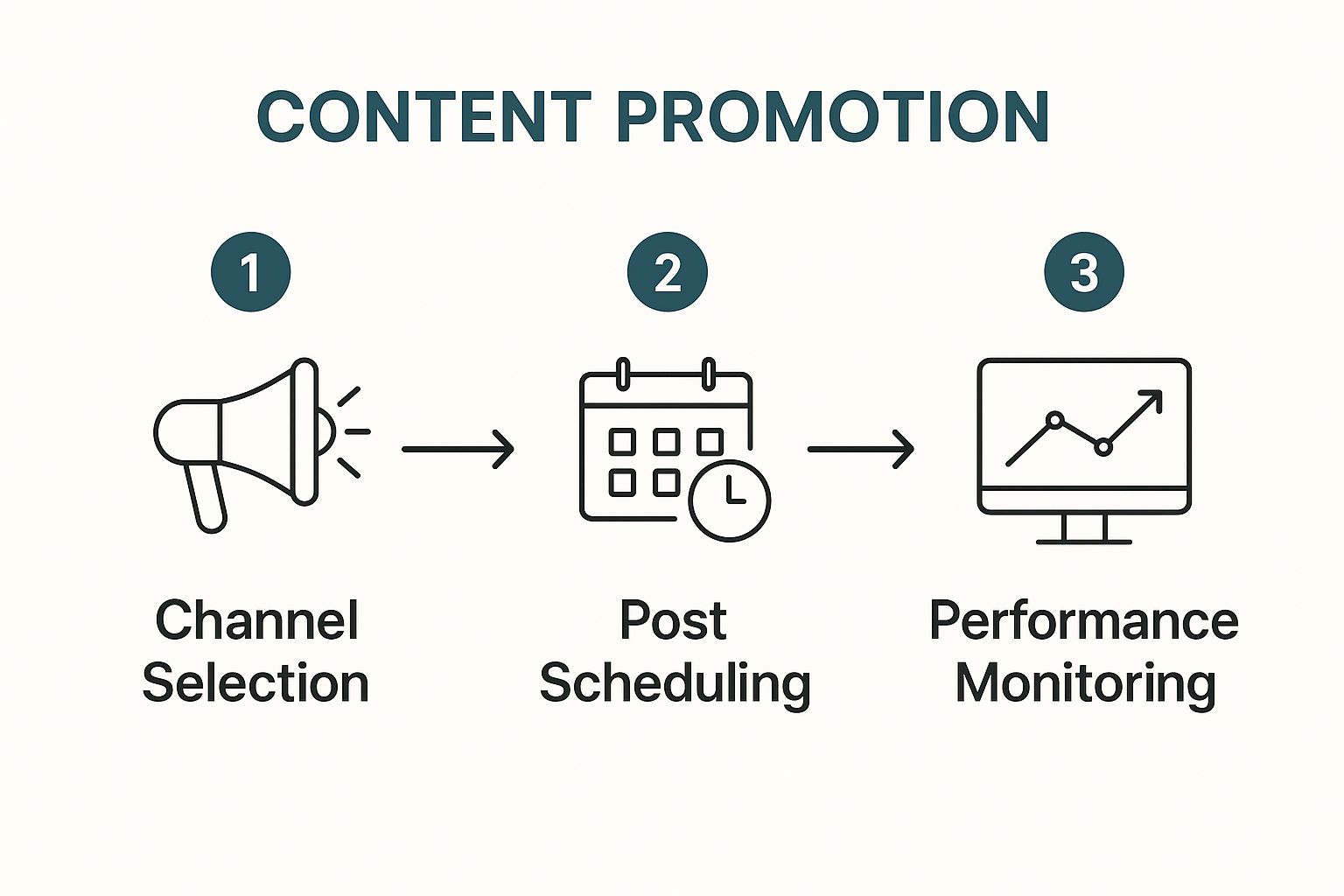
Before you write a single word, internalize this: the best content comes from listening. I’m not talking about dusty buyer personas or vague guesses. I’m talking about building a system to tap directly into the real conversations your ideal customers are having, right now. This is how we create content at BillyBuzz that solves actual problems, not just the ones we think they have.
Stop Guessing and Start Listening
As a founder, your time is everything. You can't waste it writing content that falls flat. That's why we threw guesswork out the window and built a listening framework. This isn't about creating static documents; it's about actively monitoring the niche communities where our audience hangs out.
Making this shift from passive research to active listening is the key. It’s how you uncover the exact language, specific pain points, and burning questions your audience is already sharing. For a founder creating content, that insight is pure gold.
Our Community Listening Blueprint
To find these conversations, we go straight to the source. For us, Reddit is an unfiltered goldmine for B2B and SaaS founders. We don't just browse; we have a system for monitoring specific communities.
Our go-to listening posts include:
- r/SaaS: The hub for growth, churn, and product strategy.
- r/B2B: For sales cycles, marketing tactics, and enterprise challenges.
- r/Entrepreneur: A wider lens on early-stage founder hurdles.
- r/startups: Raw conversations about funding, MVPs, and scaling pains.
- r/productmanagement: To understand how our target users think about building and shipping.
Within these subreddits, we filter for keywords like "customer feedback," "lead generation," "user acquisition," and competitor names. This is our first, most crucial layer of intelligence.
Setting Up Real-Time Alerts
A one-off research session goes stale fast. We use social listening tools to send us real-time alerts. Whether it’s in a tool like Mention or our own platform, we set up specific rules that act as our early-warning system.
Here's an actual alert rule we use inside BillyBuzz:
Alert Name: Competitor Frustration Signal
Monitor: r/SaaS, r/marketing, r/B2B
Keywords: ("competitor A" OR "competitor B" OR "competitor C") AND ("frustrated" OR "alternative" OR "hate" OR "switch from")
Frequency: Instant
Destination: #competitive-intel Slack channel
This simple rule pipes hyper-relevant conversations right to us. We see competitor weaknesses and customer frustrations the moment they surface. This gives us a constant stream of insights that helps us understand market gaps and spot trends before they become obvious.
We also spend time manually digging through our competitors' content—specifically, the comment sections. A single comment like, "This is a great overview, but how do I apply it with a small team?" is a ready-made idea for an article you know people need. It’s a repeatable process that ensures everything we publish is valuable from day one.
Turning Audience Insights Into Content
Collecting chatter from Reddit and competitor comments is just the beginning. Raw data is useless noise until you have a process to translate it into content that solves real problems. At BillyBuzz, we don't let these insights sit in a spreadsheet; we have a system for turning them into powerful content.
This isn't guesswork. It’s a methodical approach where we tag and categorize every piece of feedback. A question on a forum or a frustrated comment about a competitor's feature gets tagged with keywords like "pricing_concern," "integration_issue," or "onboarding_struggle." This creates a living database of our audience's biggest headaches.
From Pain Points to Content Pillars
After we've gathered and tagged enough insights, clear patterns emerge. For example, we might see a dozen comments in one month about the difficulty of tracking Reddit conversations without spending hours searching manually. That's not just an observation—it's a bright, flashing signal for a new content pillar.
That single theme tells us we need a cornerstone blog post, maybe a short video, and a series of social media tips all tackling that one specific problem.
We then map these themes to different stages of the buyer’s journey:
- Awareness: A founder complaining about missing leads on Reddit? They need a high-level "how-to" guide.
- Consideration: Someone asking for alternatives to a competitor is in evaluation mode. This is the perfect time for a detailed comparison post.
- Decision: A user asking about specific feature integrations is further down the funnel. They're looking for a concrete case study or a demo.
This process ensures every piece of content is a direct reflection of our audience's reality. When you solve the exact problem they're already talking about, you build trust from the first interaction.
Building Your Content From a Single Insight
Let’s walk through a real example. We spot this question in r/SaaS: "How are you guys using AI to spot trends in social media conversations without it feeling like a full-time job?"
This one question is pure content gold. Instead of just dropping a quick answer, we see it as an opportunity to create multiple assets:
- A Cornerstone Blog Post: We’d write a deep-dive guide on How AI Detects Trends in Social Media Conversations, showing our exact step-by-step process.
- A Webinar Topic: This insight easily becomes a live session titled "From Noise to Signal: Using AI to Find Your Next Customers on Reddit."
- A Few Social Snippets: We can pull key takeaways from the main blog post and turn them into short, punchy tips for LinkedIn and X (formerly Twitter).
The goal is to stop creating content for your audience and start creating content from their own words. This shift from broadcasting to reflecting is what separates generic content from truly engaging content that builds a loyal following.
To give you a clearer picture, here’s a simplified version of the framework we use to turn these observations into a concrete plan.
Our Content Ideation Framework
This table breaks down how we convert raw audience insights into actionable content ideas.
| Insight Source | Identified Pain Point | Content Format Idea | Key Takeaway for Reader |
|---|---|---|---|
| Reddit r/SaaS Thread | Manually tracking brand mentions is too time-consuming. | In-depth "How-To" Blog Post | You can automate social listening to save 10+ hours per week. |
| Competitor's G2 Review | A key feature is unreliable and buggy. | "5 Signs Your Tool Isn't Working" Checklist | How to spot the red flags and find a more reliable alternative. |
| LinkedIn Comment | Confusion over how to measure the ROI of social media. | Explainer Video & Template | A simple framework (with a free spreadsheet) for tracking content ROI. |
| Sales Call Question | "Does your tool integrate with Slack and Salesforce?" | Detailed Case Study | See how a similar company used our integrations to boost lead flow by 30%. |
As you can see, this system ensures every idea is rooted in a genuine need.
Once you truly understand your audience's needs and where they hang out online, you can explore these proven content creation ideas to spark engagement to keep your calendar full. This approach transforms your content strategy from a guessing game into a repeatable, data-driven engine for growth.
Writing for People, Not Just Algorithms

Let’s get one thing straight: SEO is a critical tool. But the moment you write for a search engine instead of a human, you’ve lost. Our philosophy at BillyBuzz is simple—write for founders, by founders. Every word has to earn its place by being clear, useful, and to the point.
Forget long, dense paragraphs. Your audience is scanning your article on a phone between meetings. They only read about 20% of the text on a page. You have to make every second count. We build everything for scannability from the ground up.
Our Human-First Writing Principles
We approach our blog content like we’re having a direct conversation with another founder. We kick corporate jargon to the curb and speak the same language we hear in customer interviews and see on Reddit. An authentic voice isn't a nice-to-have; it's how you build trust when nobody knows who you are.
Our internal style guide has a few non-negotiable rules:
- Paragraphs are 1-3 sentences. Period. This forces clarity and creates white space.
- Subheadings must answer a question. Instead of "Our Process," we’ll use, "How Do We Find Actionable Insights?"
- Use bold for key takeaways. This guides the reader’s eye to the most important points.
SEO gets people to the page, but readability and a genuine human voice are what make them stay. If your content doesn't connect, your bounce rate will tell you everything you need to know.
From Writing to Community Engagement
This founder-to-founder voice isn't just for our blog. It's how we show up everywhere. When we jump into a Reddit thread, we're not there to drop a link and run. The goal is to add real value first.
Here’s our go-to response template for engaging in a relevant thread:
- Acknowledge and Validate: "Great question. We ran into this exact problem when we were scaling."
- Offer a Concise Solution: "We found that focusing on [specific tactic] helped us cut through the noise. The process was: 1) Do X, 2) Do Y, 3) Measure Z. That alone saved us ~5 hours a week."
- Provide a Resource (No Hard Sell): "We wrote a full breakdown of the framework here if you want to go deeper. Hope it helps!"
This small shift turns a simple comment into a genuine opportunity to build a relationship. It's personal, not promotional. Balancing solid SEO with this human-first mindset makes your content both discoverable and genuinely enjoyable to read.
Investing in Creator Collaborations

As a founder, I learned you can't buy trust with ad spend. You have to earn it. At BillyBuzz, we build trust by partnering with creators who already have a genuine connection with our audience. This isn't about shoutouts; it's a fundamental piece of our content strategy.
Relying only on your own brand's voice caps your reach. No matter how great your content is, people know you have something to sell. Creator collaborations break through that barrier by tapping into existing credibility.
Finding the Right Creators for Your Brand
Forget chasing massive follower counts. Our sweet spot is with micro-influencers—true experts with smaller, highly engaged communities in our niche. These are the folks already leading the conversations our ideal customers pay attention to.
We use our own tool to pinpoint them by setting up alerts in specific subreddits, like r/SaaS and r/marketing. Our rules filter for users who consistently give thoughtful answers.
Here's an actual alert we use:Monitor r/SaaS for comments over 200 words containing "customer acquisition" or "growth tactics" with more than 10 upvotes.
This simple rule helps us find the real subject matter experts—the people who have earned the community's respect, not just the ones who shout the loudest.
The goal is to find partners whose audience trusts their recommendations. A sincere endorsement from a niche creator with 1,000 true fans is worth far more than a generic mention from a celebrity with a million passive followers.
How We Structure Authentic Partnerships
Once we've found a great fit, we never send a generic outreach email. We mention their specific, high-value comments to show we've paid attention. We don't ask for a shoutout; we propose creating something valuable together that benefits their audience.
This could be:
- A joint webinar where we both share insights.
- A guest post on our blog featuring their unique framework.
- A collaborative report analyzing a new industry trend.
The point is to build on their unique perspective. It’s no surprise that creator marketing spending has jumped by 143% since 2021—and a whopping 70% of brands say creator campaigns give them the best ROI. If you want to dive deeper into this, you can check out the latest creator marketing statistics.
Success isn't just referral traffic. We measure it by the quality of the conversations that follow. When their audience starts engaging with our brand, we know the partnership was a win. It’s trust by association.
Our Content Distribution Playbook
Great content is useless if no one sees it. If you spend 10 hours crafting a post and your only next step is hitting "publish," you're leaving most of its potential on the table.
At BillyBuzz, we live by the 20/80 split. We spend 20% of our time creating content. The other 80% is all about distribution—getting it in front of the right people.
This isn't about hoping for organic traffic. It's about actively pushing your work into the channels where your audience already is. For us, that means every long-form article gets sliced and remixed to extend its life and reach.
This visual gives you a peek into our promotional workflow, which is all about picking the right channels, scheduling our posts, and keeping a close eye on what’s actually working.

This feedback loop is critical. It shows us what’s resonating so we can double down on the good stuff and ditch what isn't.
Our Content Repurposing Matrix
We have a "create once, distribute forever" mentality. A single, well-researched article is the seed for a dozen other pieces of content. Think of it as maximizing the return on your initial time investment.
We’ve put together a simple matrix to show how we turn one core content asset into multiple pieces tailored for different channels.
Our Content Repurposing Matrix
| Core Asset | LinkedIn Post | Twitter Thread | Short-Form Video | Newsletter Snippet |
|---|---|---|---|---|
| "How-To" Blog Post | A text-and-image carousel with the top 3-5 steps from the article. | An 8-tweet thread breaking down the core concepts with a link back to the full post. | A 60-second "talking head" video script covering the single most important takeaway. | A brief summary of the post's key insight with an exclusive tip for subscribers. |
| Case Study | A success story post tagging the client, highlighting key metrics. | A short thread quoting the client and sharing one surprising result. | A quick video testimonial or a graphic showcasing the ROI achieved. | A "behind-the-scenes" look at the project, sharing a lesson we learned. |
This system ensures that every piece of content we create works as hard as it possibly can for us.
Finding Our Highest Engagement Channels
Blasting your content across every social platform is a waste of time. We focus on high-signal, niche communities where people are having real conversations. For us, that’s targeted subreddits and private Slack groups.
Our approach is never to just drop a link. That's spam. Instead, we aim to become a valuable part of the community first. We’ll find a relevant discussion, add a genuinely thoughtful comment, and only link to our content if it directly helps answer the original question. It's a simple, human-first approach. For more on this, check out these proven strategies to increase website traffic.
We’ve discovered that a helpful, detailed comment on Reddit can often get more traction than the original post itself. When you add real value, you put your content in front of exactly the right people without it ever feeling like a sales pitch.
This community-first strategy is a cornerstone of our playbook. It's so effective, in fact, that we've seen how Reddit posts now rank on Google, turning these simple conversations into valuable, long-term SEO assets.
Frequently Asked Questions
As founders, we get asked the same questions over and over about creating content that actually works. So, here are the straight answers we'd give you, based on what we do at BillyBuzz.
How Do You Measure Engagement Beyond Likes And Shares?
Vanity metrics are an ego boost, but they don't keep the lights on. We focus on indicators that show someone is leaning in.
We watch scroll depth, time on page, and the quality of the comments. Are people asking smart follow-up questions? Are they sharing their own stories? That’s when you know you’ve struck a chord.
But the single most important metric we track is "Content-Sourced Demo Requests" in our CRM. Knowing a specific blog post or a conversation in a community led directly to a qualified lead is infinitely more valuable than a thousand likes.
What's The Biggest Mistake Founders Make With Content?
The classic trap: writing about their product instead of their customer's problems. It’s an easy mistake, but it kills engagement before it starts.
Your content needs to be 90% focused on solving the real challenges your audience wrestles with every day. When you consistently deliver that value with no strings attached, you build immense trust. The sale becomes the next logical step in the relationship, not an awkward, forced pitch.
Think of your content as a trust-building exercise.
How Much Time Should A Small Team Spend On Content?
This is less about the hours you put in and more about where you put them. A small team can't afford to publish and pray.
At BillyBuzz, we operate on the "80/20 Rule of Distribution." It has completely changed how we work.
Here’s what it looks like in practice:
- 20% of your time: Go deep. Create one fantastic, in-depth piece of content that nails a major pain point.
- 80% of your time: Take that one asset and spend the vast majority of your effort getting it in front of people. Distribute it, repurpose it, and atomize it across every channel that matters.
This method forces you to choose depth and reach over sheer volume. It’s about making every piece of content pull its weight for the business.
At BillyBuzz, we're obsessed with helping founders find and connect with new customers where they're already hanging out. Stop guessing and start listening. See how our AI-powered tool uncovers high-intent leads on Reddit, saving you dozens of hours every single week.
